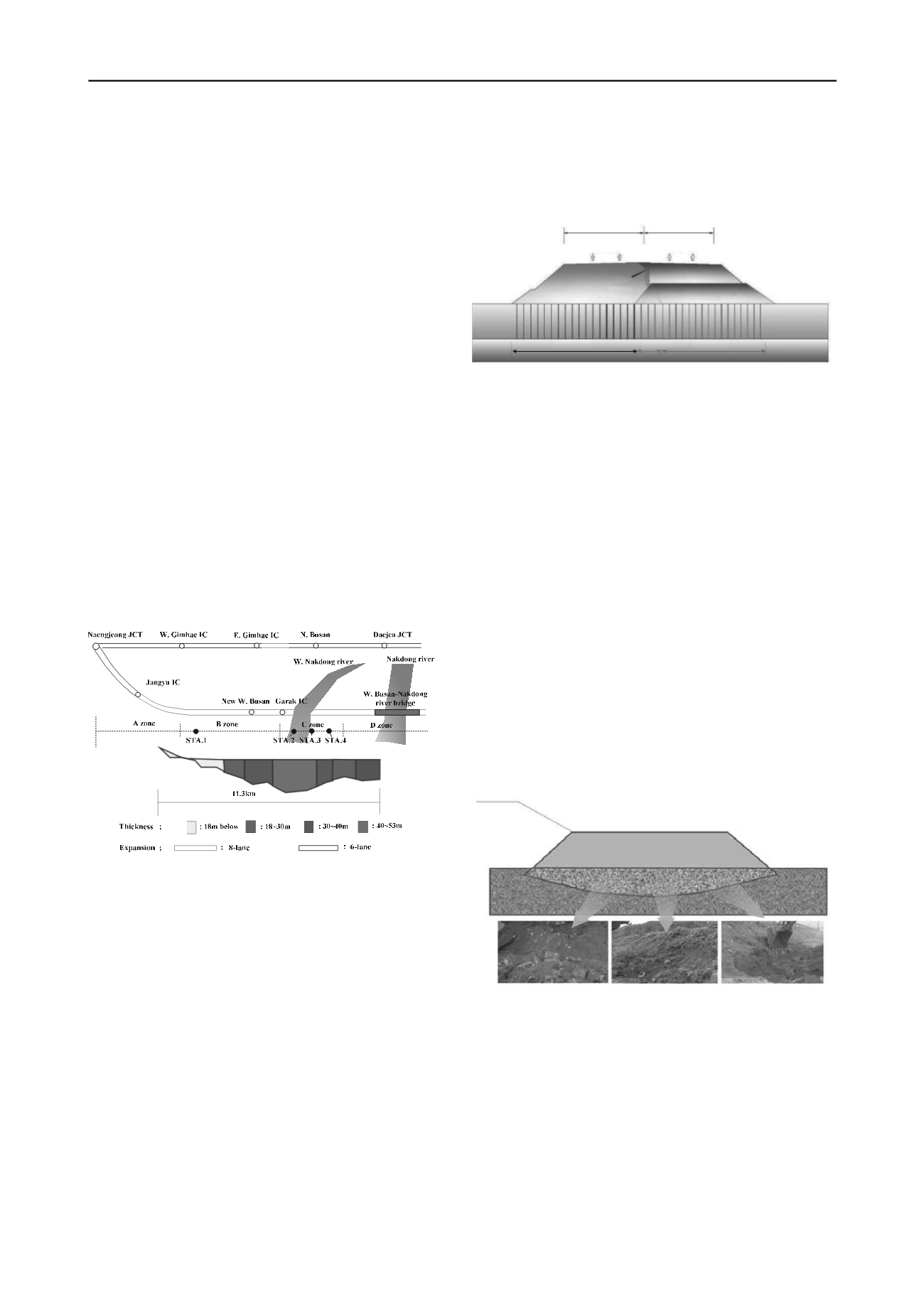
2954
Proceedings of the 18
th
International Conference on Soil Mechanics and Geotechnical Engineering, Paris 2013
associated with such problems, including future maintenance
costs. This paper outlines the problem of designing and
constructing the expansion of the second branch of the Namhae
Expressway and suggests solutions to the problems involved.
2 STRIBUTION OF SOFT SOIL ON THE PROJECT SITE
Construction of the expansion of the second branch of the
Namhae Expressway is in progress. The project has been
divided into four construction zones (A, B, C and D). The
distribution of soft soil in each zone is as follows (Korea
Expressway Corporation, 2008d; 2008e; 2008f).
In zone A, which has a total length 6.40 km, soft soil is
present at thicknesses in the range of 0.0~15.4 m in a segment
890 m in length, from station 5+110 to station6+000. According
to the results of the boring investigation, the soft soil consists of
clayey silt and silty clay. Zone B has a total length of 5.50 km
and is located across the Joman River (5+140 to 5+500). The
soft soil is present at thicknesses in the range of 2.0~50.8m
throughout zone B, except between stations 0K+000 and
1K+000. Zone C is located across the W. Nakdong River
(6K+160) and Pyeonggang Creek (8K+080 to 8K+230) and has
a total length of 3.56 km. This section also has soft soil present
at thicknesses in the range of 2.0~53 m. In the area of the W.
Nakdong River, sandy soil is present to a depth of 10~12 m due
to sedimentation from the river, and soft clay soil is present
below the sandy soil. In zone D, soft sandy soil is present at
thicknesses of 2.9~11.4 m, and soft clay soil is present at
thicknesses of 8.0~25.2 m. The soft clay soil consists of clayey
silt or silty clay.
Figure 1. Route map of expansion construction for the second branch of
the Namhae expressway and distribution of soft soil along the route.
3 THE ORGINAL DESIGN
Most of the new construction zones were planned to be
expanded bordering the existing road in the direction of
Naengjeong, except for a portion of the zones in which the
horizontal alignment was to be adjusted. An accelerated
consolidation method was applied to satisfy the requirement of
10 cm of allowable residual settlement. PBDs were selected as
the vertical drain type to be used in the consolidation
acceleration. For horizontal drainage, fiber drains were to be
used in parts of zones C and D where sandy soil is present in the
upper layer. In the remainder of the zones, a crushed stone mat
was to be used for drainage.
For the existing road, prefabricated vertical drains (PVD)
were installed along 1.2 km of the roadway, equivalent to 6% of
the total length 19.6 km when it was constructed in May of
1978 (Korea Expressway Corporation, 1982). Long-term and
continuous consolidated settlement occurred in the remainder of
the zones because an embankment was built during the
operation of the road after constructing MAT using sand and
gravel and crushed stone. Thus, the construction method below
was designed for and applied to the existing road because it was
thought to be an economical method of ensuring the long-term
stability of the roadway, allowing residual settlement by
removing the existing soil, installing vertical drains for
consolidation acceleration and preloading with counterweight
fill.
1st stage expansion section 2nd stage expansion section
Naengjeong bound
Busan bound
Temporary structure
Existing road
1 : 1.5
1 : 1.8
P.B.D. installation
P.B.D. installation after drilling
P.B.D. installation after removing the existing road
Figure 2. Overview of original design of road expansion.
4 EXAMINATION OF PROBLEMS WITH THE
ORIGINAL DESIGN
4.1
Low constructability and increased costs
According to the original design, an improvement method
should be applied to the soft soil after removing the soil under
the sting road. When constructing the existing road, only a part
of the sections improved with paper drains, and the remainder
of the sections banked using sand, gravel, and crushed stone on
the lower part without vertical drains being installed. The sand,
gravel and crushed stone rested on the lower part of the natural
soil during construction and use of the road. Thus, these objects
pose obstacles to the installation of vertical drains under this
expansion construction.
Therefore, it is expected that the constructability would be
very poor because of the difficulty of removing the settled
crushed stone and transport the soils removed from the existing
roadbed. It is also expected that the costs would be increased by
the need to transport and dispose of the waste asphalt concrete
resulting from removal of the existing road. Examination of the
cores reveals that the thickness of the asphalt concrete at an
abutment is 1~1.5 m, due to repeated overlays of the pavement
necessitated by settling of the soil over a long period of time.
Expansion
section
The existing
road
Settled soils
Original
ground
Figure 3. Results of field survey of the existing road.
4.2
Problems of PBD construction on the existing Road
Typical PBD construction is not expected to be possible
because of resistance from the crushed stone and other coarse
materials in the existing roadbed. Thus, special drilling and
excavation are necessary, but these activities will delay
construction and increase costs. If the existing roadbed soil is
completely removed, the stability of the soil may be
disrupted by PBD construction. If a drilling PBD method is
applied on the slope of the existing road, it is expected that
construction will be delayed due to the additional time required
for construction processes such as drilling and filling the drilled
hall.


